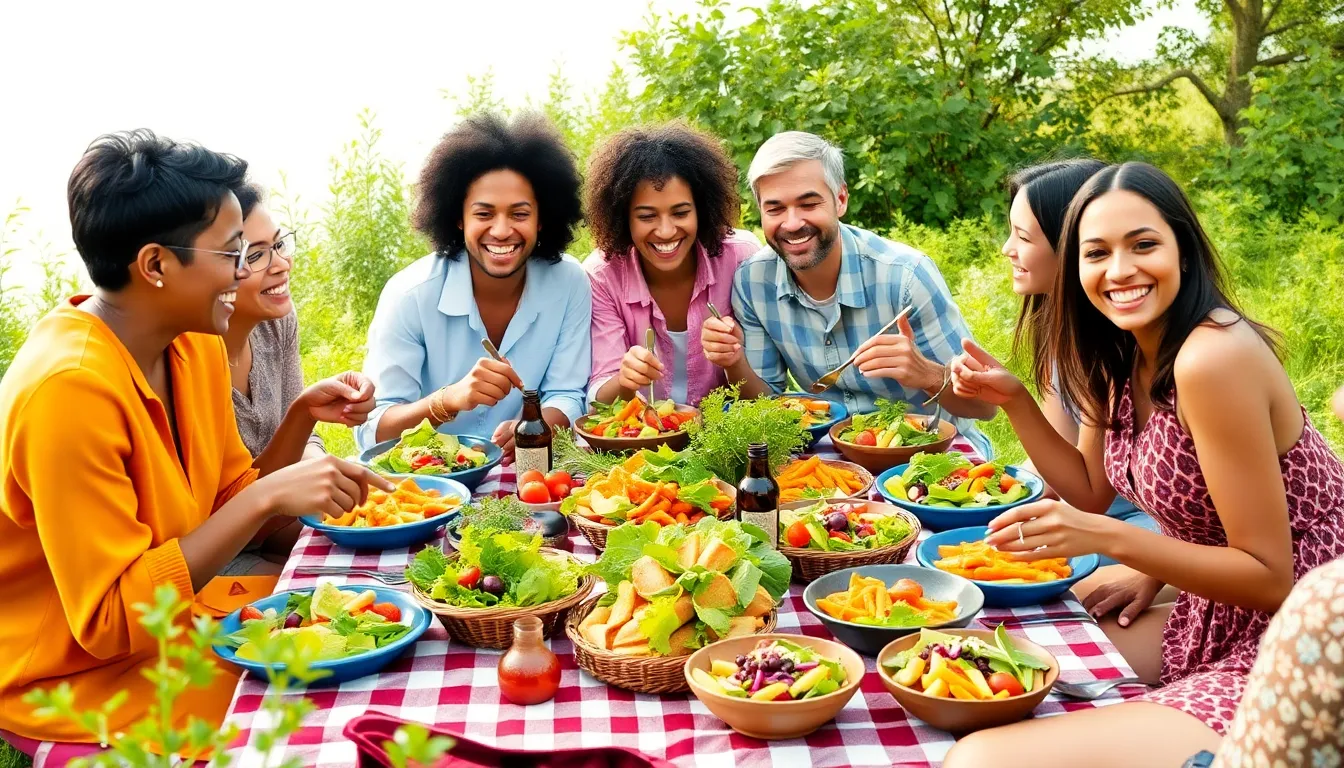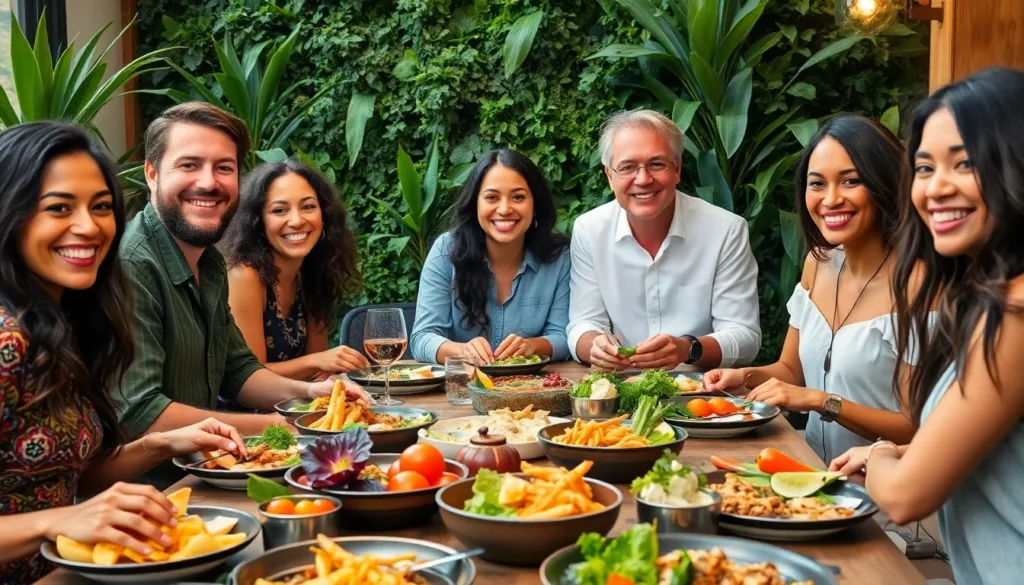In a world where food delivery apps reign supreme and gourmet meals arrive at your doorstep faster than you can say “takeout,” online food trends are evolving faster than your favorite TikTok recipe. If you think you’ve seen it all, wait until you dive into the delicious realm of fhthopefood. This isn’t just another food fad; it’s a culinary revolution that’s got foodies buzzing and taste buds tingling.
Online Food Trends Fhthopefood
Emerging trends shape the online food landscape significantly. Plant-based meals capture widespread attention, drawing consumers seeking healthier options. Global cuisines thrive on digital platforms, exposing customers to diverse flavors and culinary experiences.
Sustainability plays a crucial role in these trends, influencing food sourcing and packaging methods. Organic ingredients gain popularity, with people prioritizing quality and environmental impact. Meal kits also see increased demand, allowing users to prepare gourmet meals at home easily.
Convenience remains a vital factor in the success of online food services. Customers prefer quick access to their favorite dishes with just a few clicks. Subscription models gain traction, providing users with recurring deliveries of curated food items tailored to their preferences.
Social media significantly drives engagement and awareness in the food industry. Food influencers share visually appealing dishes, inspiring followers to try new options. User-generated content showcases authentic experiences, reinforcing community connections among food enthusiasts.
Dining experiences evolve with the integration of technology. Augmented reality menus and virtual kitchens revolutionize how consumers interact with food online. Contactless delivery services improve safety, responding to changing consumer expectations.
Given the evolving nature of food trends, it’s evident that “fhthopefood” encapsulates a broader shift towards innovative, sustainable, and convenient dining options. The online food environment constantly adapts to meet the desires of consumers, proving that these trends are reshaping culinary experiences uniquely and engagingly.
Impact of FHTHopeFood

The rise of FHTHopeFood significantly influences consumer choices and local economies. This trend reshapes the online food delivery landscape, intertwining sustainability and quality.
Popularity Among Consumers
Consumers increasingly favor FHTHopeFood due to its emphasis on plant-based meals and global cuisines. Food enthusiasts appreciate the accessibility of diverse dishes that cater to health-conscious preferences. With a focus on organic ingredients, health benefits become a priority. Subscription models entice customers by offering curated, convenient meal selections. Interactive social media posts showcase visually appealing meals, driving engagement and sparking interest. As influencers highlight unique culinary experiences, followers explore new flavors and ideas. This growing demand reveals a shift towards innovative dining options that prioritize taste and sustainability.
Effects on Local Businesses
Local businesses experience both challenges and opportunities from FHTHopeFood’s emergence. Increased demand for plant-based options motivates restaurants to diversify their menus. Many establishments embrace technology to optimize online ordering systems and enhance delivery efficiency. Competition intensifies as small businesses adapt to consumers’ preferences for sustainability and quality. Partnerships with local farms often arise, promoting community support and emphasizing fresh ingredients. Strengthening local economies becomes vital as businesses cater to the evolving culinary landscape. Overall, FHTHopeFood serves as a catalyst for innovation, prompting local eateries to rethink their strategies and engage customers effectively.
Key Trends in Online Food Delivery
Emerging trends in online food delivery showcase significant changes favoring health-conscious eating and user engagement. The current focus highlights plant-based options and innovative meal kits, reshaping consumer preferences and culinary experiences.
Rise of Plant-Based Options
Plant-based meals gain popularity among consumers seeking healthier lifestyles. Diverse restaurants now offer a range of dishes made from vegetables, legumes, and grains, catering to dietary needs. Many local eateries adapt their menus to include vegan and vegetarian options, responding to demand for sustainability. Research shows that 41% of Americans prefer plant-based alternatives due to their health benefits and environmental impact. Increased visibility on social media contributes to this trend, as food influencers promote innovative recipes and products. This shift towards plant-based dining not only satisfies taste buds but also supports local economies by encouraging partnerships with farmers.
Innovations in Meal Kits
Meal kits allow customers to easily create gourmet dishes at home, appealing to busy lifestyles. Many services provide pre-portioned ingredients and detailed recipes, simplifying the cooking process. Flexibility is a key feature, as consumers choose from various cuisines and dietary preferences. Statistics indicate that meal kit subscriptions grew by 25% this year, reflecting consumers’ desire for convenience and culinary exploration. Brands increasingly focus on sustainability, using eco-friendly packaging and sourcing local ingredients. Technology enhances the user experience, enabling easy customization and delivery tracking. As meal kits gain traction, they contribute to an evolving food landscape that values convenience and quality.
The Role of Social Media in Food Trends
Social media significantly shapes food trends, drawing in enthusiasts and promoting new culinary experiences with immediacy and impact.
Influencer Marketing
Influencer marketing thrives within the food landscape, where personalities showcase vibrant dishes that entice followers. They create excitement and trends by sharing unique recipes or dining experiences. A study found that 49% of consumers rely on influencer recommendations when deciding what to eat. Engaging with these content creators drives brand visibility, allowing companies to reach niche markets effectively. Increased trust in influencers leads to higher conversion rates, as viewers often replicate the culinary experiences they see. Authenticity of influencers matters, as followers appreciate genuine food experiences over scripted advertisements.
User-Generated Content
User-generated content enriches the food scene by encouraging customers to share their personal experiences with various dishes. Platforms like Instagram and TikTok enable food lovers to post photos and videos of their meals, fostering community engagement. Positive reviews influence the choices of potential consumers, leading to increased orders for featured dishes. Brands actively encourage online feedback, often reposting consumer content to showcase authenticity. Surveys show that 79% of consumers find user-generated content more trustworthy than brand-created marketing. This engagement enhances a sense of connection, propelling food trends into the spotlight.
Future Predictions for Online Food Trends
Emerging technologies will continue to shape the online food landscape. An increase in plant-based meal options is likely, reflecting consumer demand for healthier choices and sustainability. Research indicates that 41% of Americans now prefer plant-based alternatives. Global cuisines will see further integration into online menus, allowing diverse culinary experiences to thrive.
Meal kits are anticipated to maintain their popularity. With subscriptions growing by 25% this year, customers appreciate the ease of creating gourmet dishes at home. Customization features in meal kits enhance user satisfaction and cater to various dietary preferences.
Social media’s influence on food trends is expected to expand. Influencer marketing will play an even greater role, with 49% of consumers relying on recommendations from their favorite content creators. Authenticity in messaging will remain a priority, as followers gravitate toward genuine experiences rather than scripted promotions.
Sustainability practices will likely become more widespread. Restaurants might increasingly partner with local farms to source fresh ingredients, promoting community support. Eco-friendly packaging solutions will also gain traction, aligning with consumer values regarding environmental responsibility.
Contactless delivery options may see further advancements. Innovations in technology will improve safety and convenience for customers. Augmented reality could enhance dining experiences, providing interactive menus that engage users in unique ways.
Consumer preferences currently emphasize health, convenience, and sustainability. These priorities will shape the evolution of online food trends and the landscape of food delivery services.
Conclusion
The emergence of fhthopefood marks a significant evolution in the online food landscape. As consumers increasingly seek healthier and sustainable dining options, the trend is reshaping their culinary experiences. The focus on plant-based meals and global cuisines caters to diverse preferences while emphasizing quality and environmental responsibility.
With technology enhancing convenience and engagement, the future of online food delivery looks promising. Social media’s role in promoting authentic culinary experiences continues to grow, fostering a vibrant community around food. As local businesses adapt to these trends, the integration of sustainability and innovation will likely drive further changes in the industry, ensuring that fhthopefood remains a key player in the dining revolution.



